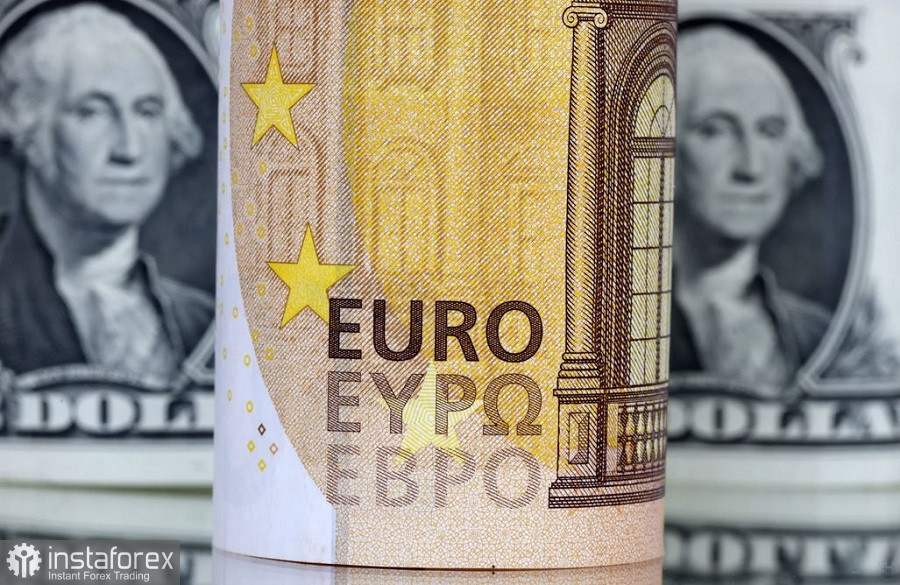Today, taking advantage of the dollar bulls' lack of decision, the euro/dollar pair is exhibiting a correction. Buyers of the EUR/USD moved closer to the third figure's edges but did not even test the 1.0300 level before returning to the middle of the second price level. This suggests that long positions are still dangerous because the pair cannot mount a significant counteroffensive, even in the face of a brief weakening of the dollar.
The fundamental background also doesn't help the southern trend turn around. Even the recent 400-point march to the 1.0480 mark should be considered a forced corrective pullback. The stars "converged" at that time for such a potent northern breakthrough:
- The American inflation report came out in the red.
- The Federal Reserve announced a pause in rate hikes, and the United States and China leaders met at the G20 summit.
- Quarantine COVID restrictions were loosening up a bit in China itself.
Buyers of the EUR/USD were able to update the 5-month price maximum because all these unipolar fundamental factors appeared almost simultaneously.

Today, the circumstances have drastically changed. The current state of information does not support a second march up the north. Additionally, recent remarks made by ECB officials increased pressure on the euro, making things worse for EUR/USD bulls. Philip Lane, the European Central Bank's chief economist, stated that the regulator is likely to slow the rate of an interest rate increase at the next meeting (in December). He made it abundantly clear that the 75-point increases were over. Mario Centeno, Villeroy de Galhau, and Klaas Knot all made statements along the same lines.
It should be noted that starting with the next meeting, the Fed also plans to reduce the rate of rate increases. However, many American regulator members urge against overstating this move's importance. After all, the US dollar's main strength lies in the Federal Reserve's ability to change the upper bound of the current PEPP tightening cycle, eventually exceeding the 5 percent rate level. Additionally, slowing the rate of monetary policy tightening does not automatically solve the problem. Fed members will discuss this move's feasibility at their December meeting. The dynamics of inflationary growth in the United States in November will play a significant role. The 75-point scenario will be on the agenda if the release is in the green zone, reflecting the renewed growth indicators.
In other words, the dollar is currently in a strong position. Several fundamental factors gradually strengthen the EUR/USD southern trend. For instance, the dollar will have another justification to strengthen its positions if the Fed's November meeting minutes are hawkish. I should remind you that the document will be released on November 23. Additionally, it is important to keep in mind that several Federal Reserve members, including Waller, Cook, and Bullard, stated last week that the US inflation rate is still too high and that it is too early for the Central Bank to consider lowering its hawkish rate. The ECB is sending conflicting signals at the same time. Mario Centeno, a Central Bank's Board of Governors member, stated that the regulator "has already implemented the majority of the necessary rate increases to curb inflation in the eurozone."
The decline in anti-risk sentiment caused today's EUR/USD price retracement. The general mood of traders was affected by news that was "de-escalating" against the backdrop of an almost empty economic calendar. For instance, Chinese Defense Minister Wei Fenghe and Pentagon Chief Lloyd Austin met for the first time today. On the sidelines of the ASEAN summit in Cambodia, they talked about regional and international security issues and defense relations between the United States and China.
Additionally, the de-escalation in the Balkans (at least temporarily) helped to lessen sentiment against risk. It was revealed that Kosovo had delayed the implementation of fines for Serbian numbers by two days. According to reports, a 48-hour delay was granted at the United States' request. Clashes in Kosovo were threatened earlier this week due to car fines, which Pristina has attempted to implement for several months. The conflict has been simmering for a while, but it was again displayed this summer. Serbia agreed to temporarily suspend entry/exit documents for holders of Kosovo ID cards as part of the dialogue with the support of the European Union, and Kosovo agreed not to implement them for holders of Serbian ID cards. This time, it's likely that the parties will reach a compromise agreement—at least temporarily.
So, despite the corrective price pullback, it still seems risky to go long on the EUR/USD pair. It is advised to open short positions with 1.0210 as the initial target using the northern bursts as justification. An intermediate level of support is provided here. The primary price barrier (the medium-term southern target) is at 1.0090. The average line of the Bollinger Bands indicator and the Kijun-sen line on the same timeframe are in sync at this price. The path to the goal of 1.0000 will become clear after passing this level.





















